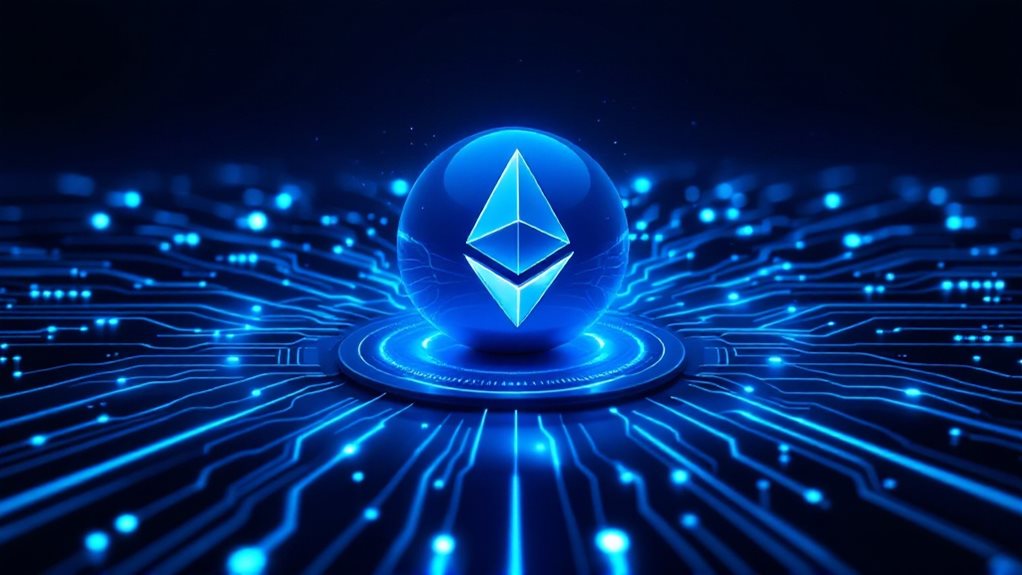The Ethereum Virtual Machine (EVM) is the engine room of the Ethereum blockchain network. It's a decentralized computing system that processes and executes smart contracts, which are programs that run on the blockchain. The EVM uses a special system of gas fees to manage resources and prevent endless loops. It acts like a giant, distributed computer that runs across thousands of machines worldwide, ensuring all transactions and programs work the same way everywhere. There's much more to discover about this innovative technology's capabilities.

The Ethereum Virtual Machine (EVM) serves as the engine room of the Ethereum blockchain network. It's a decentralized computing system that runs smart contracts and powers the entire Ethereum ecosystem. Think of it as a massive computer that's spread across thousands of machines worldwide, working together to process and execute code in a secure and reliable way.
The EVM sits on top of Ethereum's hardware and network layers, acting as a runtime environment where all Ethereum accounts and smart contracts live. It's responsible for computing the network's state and turning smart contract code into something the network can understand, called bytecode. What makes the EVM special is that it's Turing-complete, meaning it can handle any computational task, as long as there's enough time and resources. The machine's last-in-first-out principle ensures efficient data processing and execution of smart contract instructions. The EVM maintains precise execution by interpreting 140 distinct opcodes for processing transactions. The EVM's modified Merkle Patricia Tree represents the network's state and transaction data.
One of the EVM's most significant jobs is executing smart contracts that developers write in languages like Solidity and Vyper. It uses a stack-based architecture that can handle up to 1024 items and operates using opcodes – specific instructions that tell the system what actions to perform. The EVM makes sure that every operation produces the same result across all network nodes, which is vital for maintaining the blockchain's integrity.
To keep things running smoothly, the EVM uses a system called gas to manage computational resources. This prevents programs from running indefinitely and helps regulate network usage. The machine works with a 256-bit word size and maintains temporary memory between transactions as a byte array, allowing for efficient data processing and storage.
The EVM's design also enables something really cool: cross-chain compatibility. This means other blockchain networks can work with the EVM's standards, making it possible for different chains to communicate and share resources. It's become so popular that many newer blockchains are built to be EVM-compatible right from the start.
Another key aspect of the EVM is its sandboxed environment, which keeps smart contracts isolated and secure during execution. This protection is fundamental because it prevents malicious code from affecting the broader network.
The EVM's ability to manage state changes on the blockchain, process transactions, and support the creation of tokens has made it the foundation for thousands of decentralized applications that are changing how people think about digital transactions and agreements.
Frequently Asked Questions
How Much Gas Is Required to Deploy a Smart Contract on EVM?
The gas required to deploy a smart contract on EVM varies considerably based on the contract's complexity.
Simple contracts typically need 100,000 to 300,000 gas units, while more complex ones can use over 3 million units.
Storage variables, external dependencies, and contract size all affect the total gas cost.
DeFi protocols generally consume the most gas, while basic contracts with minimal functions require less.
Network congestion also impacts final deployment costs.
Can Multiple EVMS Run Simultaneously on the Same Blockchain Network?
Yes, multiple EVMs can run simultaneously on a blockchain network. This happens through parallel EVMs (pEVMs) that let transactions execute at the same time.
It's like having multiple workers instead of just one. Blockchains like Polygon and Avalanche use this approach to handle more transactions faster.
Some networks even run different types of EVMs side by side, each doing specific tasks, which helps improve the network's overall speed.
What Programming Languages Are Compatible With EVM Besides Solidity?
Several programming languages work with EVM besides Solidity.
Vyper is a Python-like language that's simpler and more secure.
Yul serves as an intermediate language that's great for optimizing smart contracts.
While Rust typically isn't EVM-native, it can work with additional tools.
There are also languages like LLL, Flint, Fe, LLLL, and Huff. Each has unique features, but Vyper is becoming increasingly popular among developers for its straightforward approach.
How Does EVM Handle Transaction Failures and Error Recovery?
The EVM handles transaction failures through several built-in processes.
When something goes wrong, it automatically cancels all changes and returns funds, except for used gas fees. It's like hitting "undo" on a computer.
The system uses revert operations to stop bad transactions and sends error messages to help identify what went wrong.
It'll also refund unused gas and keep track of failures in its logs for troubleshooting.
What Security Measures Protect EVM From Malicious Smart Contract Attacks?
The EVM has multiple security layers to protect against malicious smart contracts. It uses sandboxing to isolate contracts, preventing them from accessing external systems.
The gas system limits computational resources and stops infinite loops. Access controls restrict function permissions to authorized users.
Additionally, formal verification tools and professional audits check contracts for vulnerabilities before deployment.
These measures work together to maintain blockchain security and protect users.





